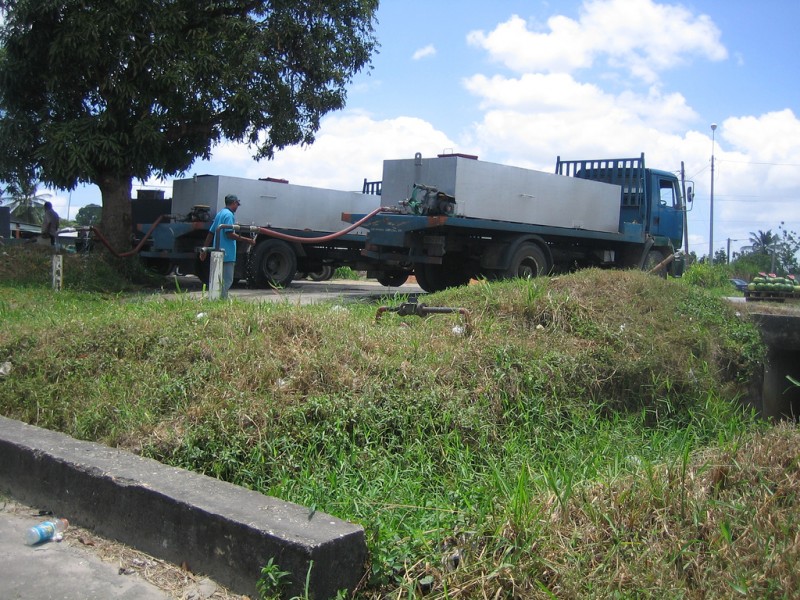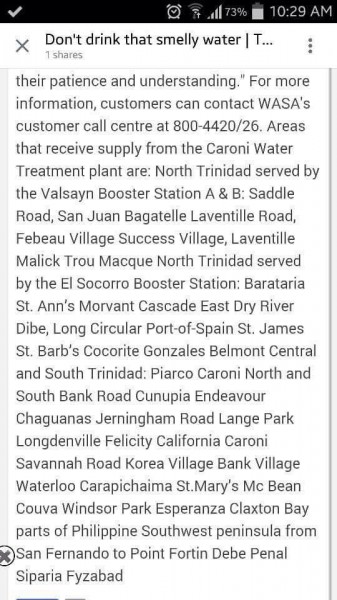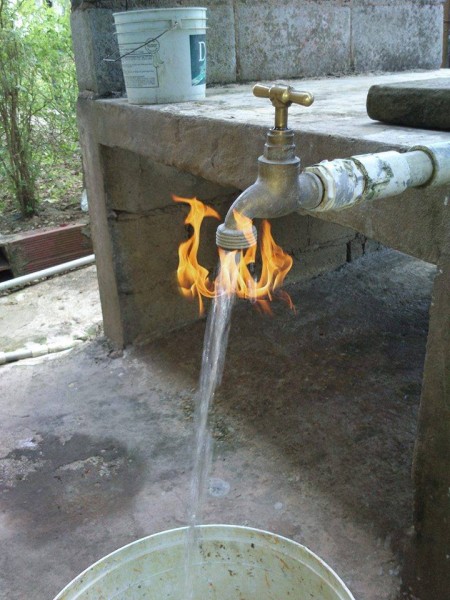
“Loading The Water Trucks in Montrose”. Photo by Taran Rampersad, used under a CC BY-NC-SA 2.0 license.
Trinidad and Tobago's Water and Sewerage Authority (WASA), the public entity charged with the reliable delivery of pipe-borne water to the country, admitted that the safety of the water supply was compromised this week after residents in central Trinidad noticed a strange smell coming out of their taps and an oil-like film in the water.
The company's website still has no information on the situation (up to the time this post was published, this was the most recent press release, about a water supply interruption last month), but it did issue a statement via its Facebook page:
At 7:15 p.m. on Tuesday 24th February 2015, operators at the Caroni Water Treatment Plant observed an poly substance in the river, which led to the immediate stoppage of operations at the plant.
The facility was restarted at approximately 12:45 a.m. […] Wednesday 25th February 2015, after the river was cleared of the oily substance, as well as clean up and disinfection works on the plant.
The Authority assures customers that the supply from the Plant is safe and meets World Health Organisation standards, however, flushing exercises are currently being carried out in order to eliminate any residue of the substance that may have entered the distribution system.
In the same breath, the release advised customers “who may be experiencing a kerosene-like smell in their supply […] not to use, but allow the supply to run until it clears”. It also noted that the Environmental Management Authority (EMA) had been contacted to investigate the contaminant observed in the river.
In an update on its own website, the EMA noted that its Emergency Response and Investigations team “is scouring areas upriver of the Plant to ascertain the possible source/s of the substance while simultaneously conducting tests on the water leaving the Plant to ascertain the presence of hydrocarbon.” They have since found a renewed presence of diesel sheens in the river, which subsequently led to a second shutdown of the water treatment plant. Tests conducted at 6:30 p.m. on February 25 showed a reading of 0 milligrams per litre (mg/L) for Total Petroleum Hydrocarbons, which was an encouraging sign.
It did little to assuage the concerns of affected residents, however, and WASA soon dispatched a truck-borne water supply to critical areas. Netizens were soon sharing, after several requests to the relevant authorities, information about the areas that were served by the Caroni Water Treatment Plant:

Areas affected by the contaminated water supply. Screenshot of text message that was widely shared.
Mrs. Nanan, who lives in central Trinidad, drinks about a litre of water a day — and yesterday was no different. By mid-morning, she was experiencing nausea, chills and weakness and could not understand why. She had already drunk half a litre of tap water. Facebook user Elana Nathaniel, who lives in the same area, posted:
Since yesterday my water has been smelling like kerosene. Now I hear that the caroni dam has been compromised…DIESEL! Be careful folks
Nathaniel reported that initially the contamination “was so bad that when you flushed the toilet there was the residual oil floating and markings!” Today, her supply has improved slightly and the smell is not as strong, but her family is still not drinking it or cooking with it.
Meanwhile in T&T thought a visually composited representation of the situation would be more effective:

“Meanwhile, in Felicity” – Photoshopped image by Meanwhile in T&T's Facebook group.
Even locations in north Trinidad — densely populated areas that are mixed use zones (residential and commercial) — have discovered that they are served by the Caroni plant. Ian Wilcox, who lives in the heart of Woodbrook, reported that he woke up this morning to the discovery that his water had a funny smell. “You could have lit a match in there,” he said, “the smell of oil was so strong.” Like many other consumers, his concern is how to get the oil residue out of his water tank. (Most households and businesses in Trinidad and Tobago have water storage facilities on their property to ensure an uninterrupted water supply, even when there is no water being supplied via the mains.)
The ODPM's initial recommendation was vague, advising people to use “household cleaning agents […] before you refill your tanks”. Facebook user Cecile Pemberton pressed them to be more specific:
Such as? Disinfectant? Detergent? Bleach?
State officials later answered that bleach was the most effective cleaning agent in this situation. In response to netizens’ concerns about health repercussions from ingesting the water, the ODPM said:
The ODPM does not hold jurisdiction in the areas of education or health. Should a school be affected, the principal or other officer in charge takes appropriate action as guided by the Ministry of Education. In the event a person experiences adverse effects as a result of ingestion of this water, they should seek medical attention from the Ministry of Health. In addition, affected persons may utilise the services of our Customer Care Centre at 511.
Some schools in the area were also affected:
At least one school in central Trinidad dismissed early today #contaminated #water #WASA
— Richard Lord (@Lordrich6) February 25, 2015
Social media users continued to share their experiences via various public Facebook threads. Eme Blake wanted to know what measures were in place to test the country's water supply on a regular basis:
Can you please advise what Trinidad and Tobago's drinking water standards are? (How often is water sampled and tested? For which contaminants? What are the MCLs etc.) I cannot find any data online.
Roelle Donwner, who also lives in Woodbrook, was disappointed in the level of communication with citizens over what she considered a pressing public health threat:
I had to hear about this from a friend about 8am this morning and checked my water and sure enough there was a smell […] I tried calling WASA customer service SEVERAL times with no success. I decided to contact the EMA head office in POS and they said they weren't aware of the situation and gave me a number for the central office. They confirmed the situation and I ranted about there not being an offical release anywhere. Apart from households being affected by this what about schools and hospitals that were not aware??? This should have gone out as a bulletin on TV, Radio and Social Media!!! […] Get your act together Trinidad!!
Gerzel Serrette-Soverall, who is pregnant, also thought the advisory came too late:
This is a bit to [sic] late wasa, since monday i notice that once i drank the water i hv experience[d] excessive bowel movements. I hope tht my un born baby is ok.
Official sources are not yet confirming whether or not the contamination was an act of sabotage, but there were many calls for whoever was responsible to face some sort of consequences, whether or not it was accidental. What many people cannot understand is why, when WASA discovered the problem on the night of Tuesday, February 24, the plant was not immediately and permanently shut down — at least until the source of the contamination was found and stopped, and the integrity of the water supply could be verified. Mrs. Nanan said:
What I CANNOT understand is that WASA knew the water was contaminated but still sent it to people from Tuesday. There was water by me right through Tuesday until Wednesday.
The water supply to her area was only turned off during the wee hours of Thursday morning. She is calling for better security at the dams, as she realises how easy it is for the water to be contaminated. In response, WASA has said that they intend to step up security measures:
#WASA says it is heightening security at Caroni plant.. and intensifying probe into recent spill @i955fm
— Nicole Romany (@1Nicoleromany) February 26, 2015
As of the time of this writing, WASA still had not determined what the contaminant actually is. The consensus on Twitter was that it was kerosene, but this suspicion is yet to be confirmed.
@msconfident20 #onlyinTrinidad #WASA ….they say someone threw kerosine in the resevoir
— Israel O'Neil (@oneil_08) February 26, 2015
Who the hell dumps kerosene in a water treatment plant? Now we're warned not to drink smelly water. #SweetTrinidad #WASA
— 50 Grades of Shea (@CheyenneB) February 25, 2015
One citizen, who preferred not to be named, said that he heard a radio interview on Thursday afternoon with a WASA official, who explained that the company has measures in place to detect contaminants below the water, but not on the surface. The organisation is apparently in the process of purchasing the required equipment to test surface level contaminants, as well.







1 comment